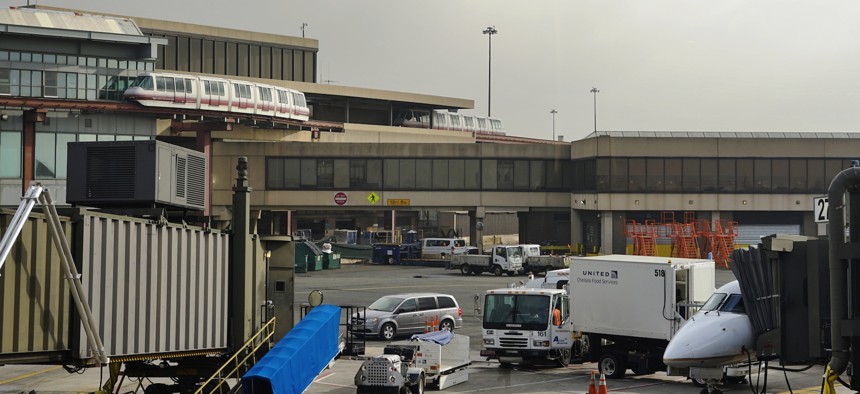Rethinking Our Century-Old Approach to Paying for Infrastructure

Newark Liberty International Airport Shutterstock
Our crumbling infrastructure can be fixed if we change how we fund capital investments and maintenance.
In the United States, we routinely separate “capital” activities from “maintenance and repair” activities. This made sense in 1916, when Congress began funding the U.S. highway network. Federal funds were only to be used to subsidize “capital” expenses—costs incurred in the design and construction of infrastructure assets. Maintaining assets throughout their service life was to be funded by the states, from “operating” or “maintenance” budgets, with legislative appropriations separate from “capital” budgets.
Every subsequent federal grant program followed the 1916 model. So, too, did state grants to local governments.
The consequences of focusing too much on initial delivery surround us: crumbling bridges, poor roads, old airfields, outdated terminals, congestion. Decades of American Society of Civil Engineer Report Cards trumpet the poor condition of infrastructure—grading them with Cs, Ds, and Fs—and warn of the extraordinary backlogs in deferred maintenance and repair.
Our present difficulties come from the fact that the long term operating costs of core infrastructure assets are ten to twenty times that of initial delivery. With our present management systems, state and local jurisdictions cannot afford the cost of proper life-cycle operations, maintenance, and repair.
The separation of “capital” from “maintenance and repair” activities is at the root of these problems, and creates significant difficulties for state and local procurement.
During initial delivery of a new infrastructure asset, two separate procurements are typically required—one for design and a second for construction. During that asset’s 35-year life, though, there will be hundreds (or even thousands) of required maintenance and repair activities to be identified, scheduled, and completed.
Our research at MIT confirms that bundling initial delivery with long-term maintenance regularly produces life cycle cost savings of 30 to 40 percent, solidifies level of service commitments, and reduces the number procurement transactions. Cost savings come from design and operation configured for longer life with lower maintenance and energy expense.
Of course, bundling “capital” with “maintenance” activities doesn’t make sense for every infrastructure asset. In-house performance of maintenance activities will not, and should not, go away. But, there are many scenarios where it is necessary to question whether “capital-maintenance” divide continues to make sense.
For example, roofing, heating, air conditioning, telecommunications, internet, wireless and cable are systems whose technological components continue to change rapidly. For components like these, meeting the committed “level of service” is the focus—not whether it is met through a “capital” or a “maintenance” expense. These are the kinds of systems for which life-cycle arrangements often make sense when closely tied to guaranteed levels of service.
Such contractual arrangements take many future procurement actions off the table, along with appropriation decisions to fund them. Careful bundling of “capital” and “maintenance” activities into longer term contracts improve levels of service, lower life-cycle costs and use less procurement resources—a triple win.
State and local procurement mechanisms need to be opened up to make the full menu of project delivery and finance alternatives available. Canada, Australia, Holland, Scotland, England, and London regularly use competitive procurement methods that allow “capital” and “maintenance” activities to be procured separately or together, depending on project circumstances. Infrastructure Ontario, for example, employs detailed projections of traditional sources and uses of funds as a competitive benchmark for bundling “capital” and “maintenance” activities in a single procurement.
State and local governments in the United States are exploring these mechanisms. A good example is Seattle’s Tolt River Water Treatment Project. Seattle first built its best estimate of life cycle cash flow over 30-plus years, assuming “public” delivery. The city then announced that it would accept “private” delivery proposals, but only if they produced a life cycle cost savings of at least 15 percent. The winning proposals reduced the Seattle’s life cycle cost by nearly 40 percent.
Proven mechanisms are available to deliver the right action, in the right place, at the right time, and for the (competitively verified) right price. Competitive models like the American Bar Association’s Model Code for Public Infrastructure Procurement allow governments to get definitive commitments on levels of service and life cycle costs for every significant infrastructure project.
As the information age spreads across infrastructure facilities, long-term operation of the technological systems they contain is of increasing importance. Distinctions between “capital” and “maintenance” are falling away.
The roads, bridges, rails, runways, rivers, wire and wireless networks on which the economy runs move every city, county, and state in America. Providing high levels of infrastructure service at an affordable cost to taxpayers is an essential function of government, and one critical to the American economy.
It is time to open procurement mechanisms.
Dr. John Brown Miller is the principal at Ironside Strategies, as well as an author, speaker, and recognized expert on infrastructure.
NEXT STORY: Taming the ‘Seattle Process’ to Deliver Future Light-Rail Lines Without Delay





